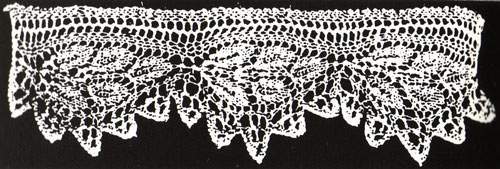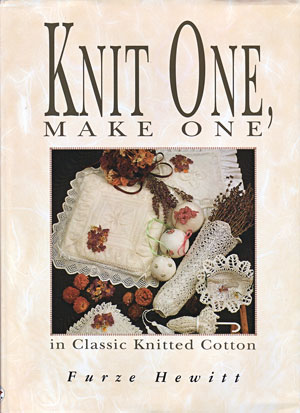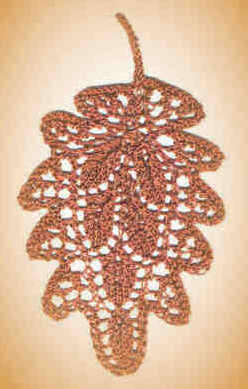Reflections on designing the 1998 oak leaf
I hope the bit-size tutorial earlier this month, Designing with Elements of Lace Edging Patterns, has been inspiring you to look at the elements of lace edgings in totally new ways. To help you along even further, I have another example to share.
The Bits of Lace Oak Leaf pattern we are doing this month is actually part of a long-awaited second installment of designs for shaped leaves in lace that I first began in 1998 with this knit lace Oak Leaf medallion.
For the Oak Leaf Medallion, my design strategy was similar to that of Bits of Lace Oak Leaf, in that a lace edging pattern was the jumping-off point. But thereafter, the approach to designing the shaped leaf was quite different. I’ll outline that here to help you grow even more ideas to use the elements of lace edgings in new ways.
My jumping-off point for the 1998 Oak Leaf was the Barbara Anne Lace edging in Furze Hewitt’s book Knit One, Make One.

Barbara Anne Lace Edging
This is from page 90 of the hard-copy edition in case you have the book with this cover. There was also a paperback edition published. Unfortunately, the books are pretty rare to find these days. The discussion here is not dependent on you having the book, but I did want to be clear about my source.

Don’t you think the visual detail of the Barbara Anne Lace is lovely? That undoubtedly is what originally drew me to looking at this edging.
The design for the 1998 Oak Leaf didn’t just happen without any work, though. It involved working many “what if” samples before I was pleased with the results and could chart the instructions clearly enough for others to follow.
What I ended up doing was entirely eliminating the header section along the straight edge, thus using these two elements only of the Barbara Anne edging (refer to the picture above to identify these for yourself):
- the outer section of the edging with the shaped lobes
- the interior “leaf spray” section
I then flip-mirrored the shaped lobe section on the other side of the leaf spray section. This shifts one side of the shaped lobes a row higher than the other, but it is hardly obvious except at the bind off near the stem. Since leaves are not absolutely perfect and symmetrical in nature, I actually think this adds some charm to the design.
Once I had the majority of the leaf worked out and charted, I still needed to do something for the tip of the leaf. With all the practice I had with making trial samples, I sort of just ad-libbed this to retain the same lacy look and feel in the leaf tip.
The resulting 1998 Oak Leaf is a one-piece design that is knitted flat without any sewing or picking up stitches. It begins with a cast on of 4 stitches, then is knitted flat from tip to base. The base of the leaf is then bound off leaving 3 center stitches, which are then worked in I-cord for the stem.
Should you be interested in knitting the 1998 Oak Leaf, the originally published pattern is still available for sale. But I must forewarn you that it is charted only and does take mindful attention as there is little repetitiveness in the 57 rows. But otherwise the knitter familiar with basic lace knitting can expect to have a fun knit with this pattern.



 HeartStrings FiberArts
HeartStrings FiberArts Knitting Bits of Lace on Facebook
Knitting Bits of Lace on Facebook Ravelry Store
Ravelry Store
Pingback: Picot Loops Lace Ribbon | Knit HeartStrings
Your design process is fascinating reading. There’s so much work that goes into designing, which one might not realize unless they have the chance to read about it or unless they’ve given it a try themselves. Thanks for sharing.